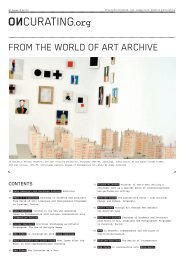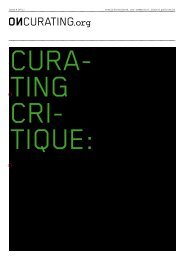You also want an ePaper? Increase the reach of your titles
YUMPU automatically turns print PDFs into web optimized ePapers that Google loves.
059 Issue # 11/11 : PublIc Issues<br />
process. This differentiates the practices of art collectives<br />
from those of social workers. Intention is the nexus<br />
between projects. One might relate the gecekondu project<br />
to the notion of intention, considering that it w<strong>as</strong> presen-<br />
ted at the biennial; yet it emerged <strong>as</strong> an outcome. It<br />
p<strong>as</strong>sed through the stages I mentioned above and presented<br />
itself.<br />
Here I would pose a question to the other members of Oda<br />
and Derya: what does it mean to exoticise a situation?<br />
Özge, do you use this term because it is about gecekondu?<br />
Would we then say, in relation to our work Picnic, that<br />
the notions of picnic and neighbourhood were exoticised<br />
<strong>as</strong> well? 3 And relative to The Picture of My life, were the<br />
contributors from the neighbourhood exoticised <strong>as</strong> well? 4<br />
Derya: Well, criticism actually emerges at this stage. 5<br />
Accordingly, the response to your questions should be:<br />
"yes, there is exoticisation in these works". Exoticisation<br />
can emerge during the process <strong>as</strong> well <strong>as</strong> at the outcome.<br />
It is not intended but it may arise anyway. The crucial<br />
question is what kind of strategies can be produced to<br />
avoid this.<br />
Özge: Exoticisation means presenting a situation, ob-<br />
ject, or subject without establishing a mutual relationship<br />
or exchange with it, contending with merely seeing it,<br />
perceiving it, and displaying it to others, or indeed ex-<br />
hibiting it to others. In that respect, what I value is<br />
striving for the visibility of the established relations<br />
and for openness about further participation. And I find<br />
it understandable that the gecekondu building w<strong>as</strong> conceived<br />
<strong>as</strong> an exotic and authentic object by the audience<br />
since it w<strong>as</strong> presented in isolation from its production<br />
process (although its presentation w<strong>as</strong> supported by our<br />
Annex publication and billboard advertisements). 6 The<br />
processual character of relations brings with it stories.<br />
I don't have any problem telling these stories. I don't<br />
think that these stories are exotic. But in the c<strong>as</strong>e of<br />
Picnic and The Picture of My life there is a process;<br />
both the process and the story are visible. Perhaps Picnic<br />
can be considered a special c<strong>as</strong>e: what became a spectacle<br />
w<strong>as</strong> the constructed space and not its content; moreover,<br />
we had our experience on this constructed stage. The<br />
photographs of the neighbourhood are exotic when they are<br />
considered in their isolated presentation. But we never<br />
exhibited them in isolation; well, actually, we didn't<br />
exhibit them at all. These photographs were taken and<br />
given to their owners. What mattered there w<strong>as</strong> the mutual<br />
experience.<br />
I ˙ stanbul<br />
Seçil: Could we perhaps reformulate the question of author-<br />
ship in terms of "Istanbul and authorship"?<br />
Derya: Yes, this makes sense to me. In the final analysis,<br />
what makes us discuss issues concerning space and authorship<br />
are the spatial practices that produce everyday<br />
life in Istanbul. And we cannot start discussing Istanbul<br />
without touching on the issues of space and authorship.<br />
Seçil: The European Capital of Culture projects brought<br />
the emerging triangle between culture, art, and the city<br />
to public attention. Also, it seems that this might trig-<br />
ger attempts to redefine what is minor and what is major<br />
in the context of urban problematics of Istanbul.<br />
Özge: The concept of author-<br />
ship, just like the concept<br />
of gentrification, originates<br />
in the West. We might<br />
argue that authorship never<br />
existed here in Istanbul in<br />
the Western sense; the city<br />
w<strong>as</strong> not structured predo-<br />
minantly according to this<br />
dynamic. Perhaps we should<br />
look for a corresponding con-<br />
cept of authorship in<br />
Turkish, our own language;<br />
that is, we should <strong>as</strong>k what<br />
the equivalent for authorship<br />
would be in the context<br />
of Istanbul. Actually, space<br />
is first formed and then<br />
appropriated. That is, from<br />
the beginning there is no<br />
authorship. We can discuss<br />
the author of the space of<br />
Oda Projesi from this per-<br />
spective. The space is first<br />
established and then come<br />
the signature and naming.<br />
Seçil: Actually, what now<br />
heads the agenda are the<br />
urban lots entrusted to pro-<br />
minent, giant architects –<br />
an urban situation formulated<br />
through ownership. When<br />
we examine the scale of<br />
our existence in the Galata<br />
neighbourhood, we can talk<br />
about situations and ex-<br />
periential modes to which we<br />
partly conform and from which<br />
we borrow things <strong>as</strong> the ren-<br />
ters of a certain space.<br />
We can consider these things<br />
through the misuse value.<br />
The author of the space seems<br />
to be us – but only <strong>as</strong> an<br />
<strong>as</strong> if.<br />
Derya: The culture-arts-<br />
city triangle is actually not<br />
that new. We are already<br />
witnessing the transformation<br />
it h<strong>as</strong> entailed, I<br />
think. The cultural industry<br />
evolves into a position of<br />
comprising all of these three<br />
fields and of blending them<br />
into each other. I agree<br />
with Seçil; the process of<br />
transformation which h<strong>as</strong><br />
become evident in the l<strong>as</strong>t<br />
couple of years in Istan-<br />
bul forces us to reformulate<br />
our understanding about<br />
scales. The production of<br />
urban space in Istanbul h<strong>as</strong><br />
long been b<strong>as</strong>ed on makeshift<br />
structures, and the city<br />
h<strong>as</strong> been reproducing itself<br />
b<strong>as</strong>ed on this character.<br />
3<br />
The project<br />
undertaken by Erik<br />
Göngrich (June<br />
10th, 2001) w<strong>as</strong><br />
b<strong>as</strong>ed on his ob-<br />
servations about<br />
Istanbul <strong>as</strong> a<br />
picnic city. The<br />
courtyard of<br />
S¸ahkulu Street and<br />
its garden were<br />
open to all<br />
p<strong>as</strong>sers-by who<br />
wanted to take<br />
a breath. On the<br />
day of the court-<br />
yard picnic, every-<br />
one left their<br />
shoes "outside"<br />
and came into the<br />
carpet-covered<br />
courtyard, which<br />
became like the<br />
living room of the<br />
neighbourhood, a<br />
private space with-<br />
in public space.<br />
The courtyard w<strong>as</strong><br />
redefined in this<br />
project. Food,<br />
beverage, cutlery,<br />
pots and pans were<br />
provided from the<br />
nearest neigbourhood<br />
public market.<br />
Invitations were<br />
prepared and sent<br />
to the neighbours<br />
one week before<br />
the event. For the<br />
picnic, the court-<br />
yard w<strong>as</strong> covered<br />
with multi-func-<br />
tional pl<strong>as</strong>tic<br />
carpets. According<br />
to Eric, "wherever<br />
you put these<br />
carpets, in public<br />
or private space,<br />
the place becomes<br />
immediately<br />
yours!" Producing<br />
a sense of dis-<br />
placement with<br />
shoeless people pic-<br />
nicking on the<br />
street, the picnic<br />
posed the follow-<br />
ing question: to<br />
what extent does<br />
the distinction<br />
between "public"<br />
and "private"<br />
spaces have a<br />
relevance in the<br />
specificity of<br />
Istanbul?<br />
4<br />
Ada also included<br />
a series of acti-<br />
vities in Galata<br />
under the title<br />
saturday Meetings.<br />
Oda Projesi<br />
invited various<br />
artists to produce<br />
projects that in-<br />
volved collabora-<br />
tion with the<br />
residents of the<br />
neighbourhood. The<br />
Picture of My<br />
life, a project by<br />
Belmin Söylemez<br />
and Orhan Cem<br />
Çetin, consisted<br />
of producing photo-<br />
graphic portraits<br />
of whoever wanted<br />
to be a part of<br />
the project. The<br />
neighbours decided<br />
on the details<br />
of their portrait,<br />
such <strong>as</strong> the sett-<br />
ing, the pose,<br />
etc. This process<br />
w<strong>as</strong> video-taped.<br />
The resulting<br />
photographs were<br />
given to the<br />
participants. A<br />
collage of all of<br />
these photographs<br />
and the video<br />
footage were later<br />
exhibited in the<br />
Oda Projesi space.<br />
5<br />
Derya is grateful<br />
to Rachel Haidu,<br />
her dissertation<br />
advisor and dear<br />
friend, for her<br />
criticism on this<br />
subject.<br />
6<br />
As part of Ada,<br />
advertisements<br />
were posted on<br />
actual billboards<br />
around the city<br />
to promote a<br />
fictional gecekondu<br />
for sale.


![Download as PDF [10.6 MB]](https://img.yumpu.com/4266533/59/500x640/download-as-pdf-106-mb.jpg)

